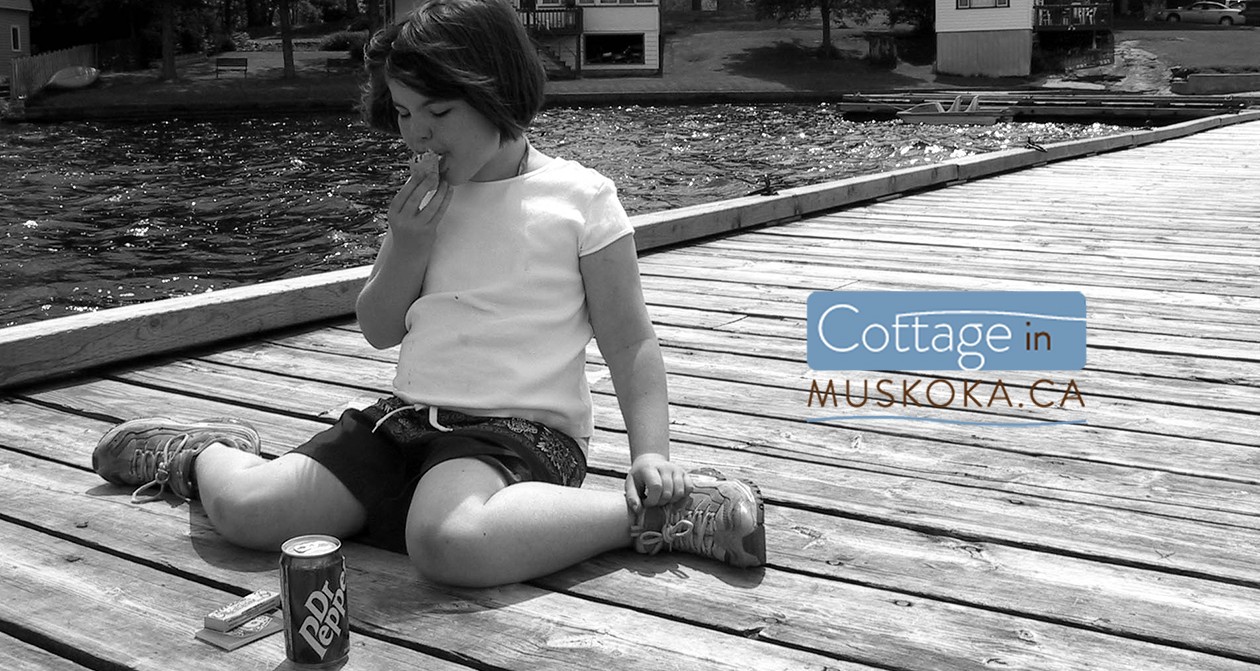The shoreline is an extremely valuable and important area – not only for personal enjoyment and property values, but for the health of our Muskoka Lakes, and the critters we share them with.
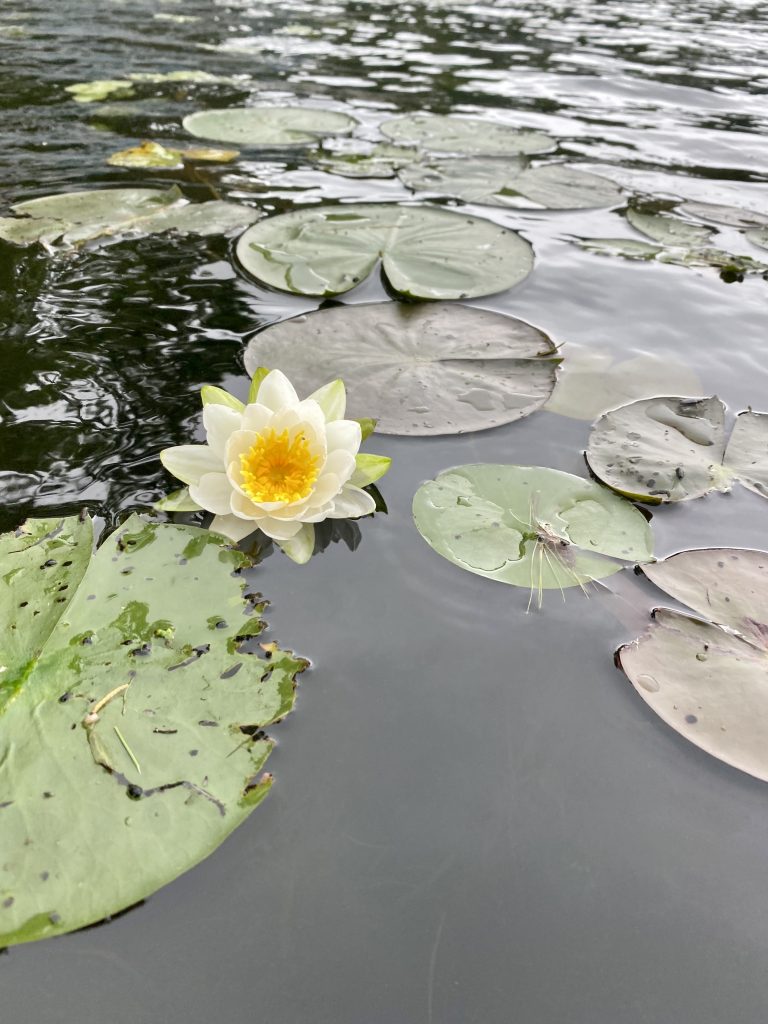
Did you know a natural shoreline can:
Protect against erosion?
A natural shoreline is perfectly engineered to protect against erosion. Native vegetation along the shoreline strengthens the structural integrity of the land and prevents it from falling apart. The roots of the plants grip the earth and provide structure, and the foliage and leaves of the plant reduce erosion caused by rainfall and winds. Aquatic plants and buffer plants right along the edge of the shoreline also lessen the effects of wake hitting the shore.
Maintain or improve water quality?
Buffer plants and shoreline gardens reduce incidences of soil erosion, which has the added benefit of protecting fish habitats.
“One could think of it this way: waterfront plant buffers are like eyelashes to our lakes: they keep the grit and goo out”
www.muskokawatershed.org
Filter overland pollutants and absorb extra nutrients?
Vegetation along the shoreline not only helps slow the movement of surface runoff, but the roots of this vegetation also help absorb surface water – trapping excess nutrients and pollutants in the soil.
An excess of nutrients like phosphorus and nitrogen is one of the factors that can cause an algal bloom – much like how fertilizing your lawn causes it to grow faster. Given that the other main factors are weather related, keeping these nutrients at a reasonable level are the best defence cottagers have against algal blooms. There are many types of algae – an excess of any of these can be harmful to the aquatic ecosystem, but some types (like blue-green algae) can have dire consequences when it comes to our health and the health of our pets. Most other common types of algae are at their most harmful once they’ve died – they sink to the bottom of the lake and decompose, reducing the amount of oxygen available to fish and other aquatic organisms.
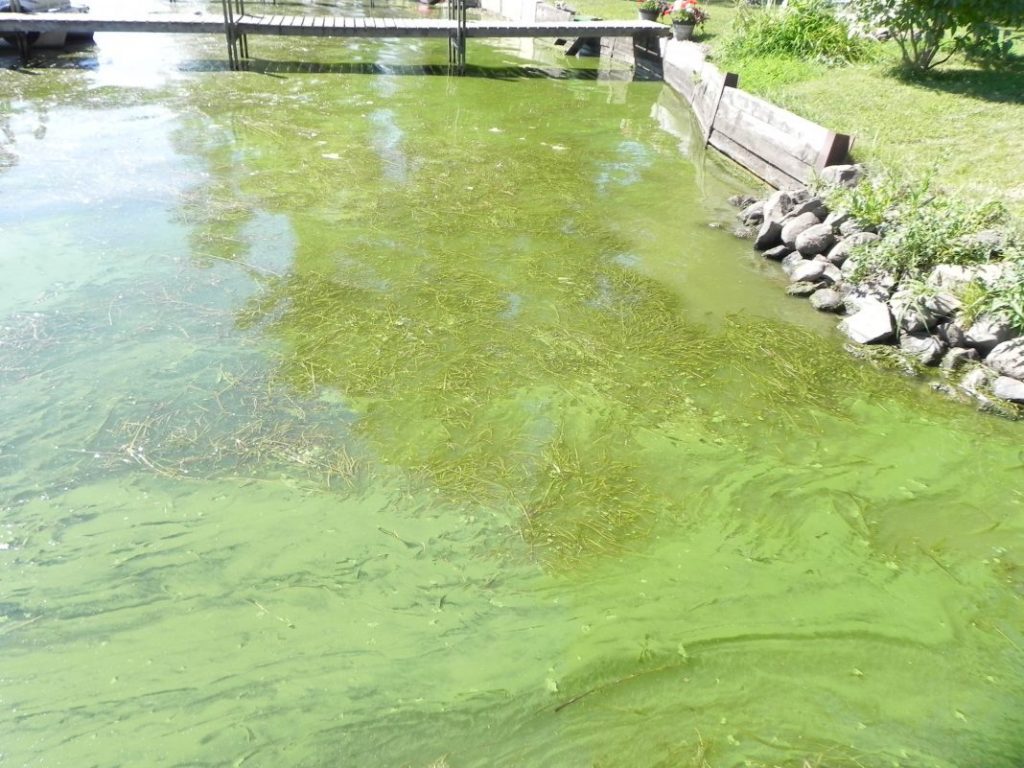
Consuming toxins from a blue-green algae bloom can include headaches, fever, diarrhea, abdominal pain, nausea, vomiting, and other more serious effects. It can also kill dogs and other animals. According to the Simcoe Muskoka District Health Unit, “people not on public water supplies should not drink surface water during an algal bloom, even if it is treated. In-home treatments such as boiling and disinfecting water with chlorine or UV and water filtration units do not protect from blue-green algal toxins.”
Blue-green algae does more than just threaten our health though – it also threatens our property values. Of particular note is the 2005 toxic algal bloom in Three Mile Lake in Muskoka, a lake which has had more than it’s fair share of blue-green algae related woes. This toxic bloom resulted in property values on Three Mile Lake dropping by about 25%. I guess that’s not much of a surprise to anyone after hearing about the health risks… but we should also mention how repulsive it can look and smell. According to former Township of Muskoka Lakes Mayor Susan Pryke, the worst hit areas of Three Mile Lake “looked like pea soup, with bits of algae floating in the water, sort of like chunks washing up on shore,” and smelled like “garbage that had been left sitting out too long.” Lovely.
Protect wildlife habitats, while ALSO reducing the number of geese that come on your property?
Throughout their lifecycles, the majority of our native Muskoka species depend on a healthy shoreline. The riparian zone (the area that lines the border of the water, with rich moist soils where diverse plant communities can grow) is used for sources of food and shelter, breeding, migration, and for rearing young. This area is also essential when it comes to preventing geese – geese are attracted to open spaces with easy access to the water, and they like to feed on short grass. If you have a goose problem then I’m willing to bet you probably have a grass lawn. A shoreline barrier of native Muskoka shrubs and tall vegetation can help deter them from hanging out on your property.
Moving into the water from the riparian zone, we enter the littoral zone – the submerged area of shoreline where the sunlight still penetrates through to the lake bottom. According to Muskoka Watershed Council, the littoral zone is “the richest natural environment that most of us will ever come into contact with,” with as much of 90% of the species in the lake either living in or passing through this zone. This area (and the aquatic plants and downed trees that it consists of) is responsible for providing oxygen to the lake, spawning areas, shallow protected nursery areas (for fish and amphibians), foraging areas, and hiding spots.
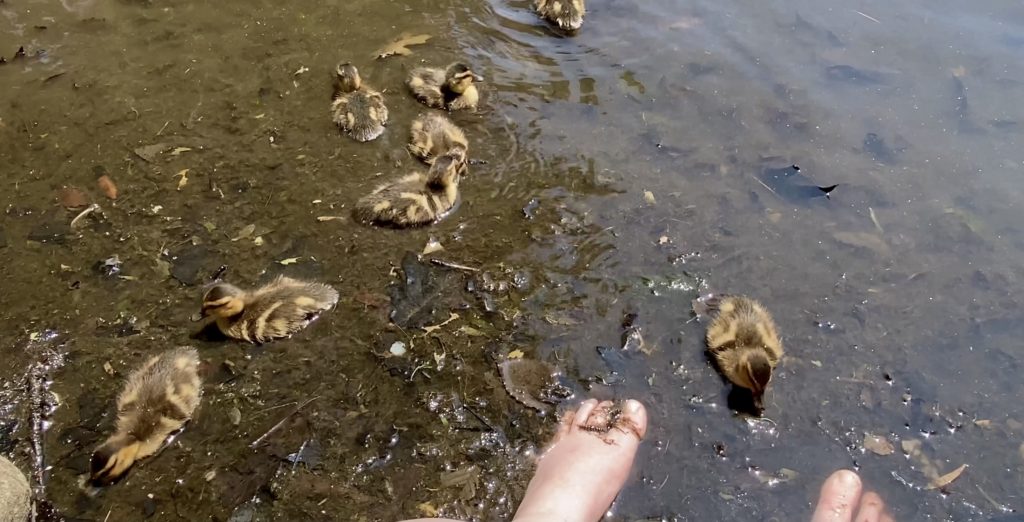
Protect the economic benefits associated with tourism?
Nature is one of the major appeals of Muskoka! Wait to catch a sunset while you watch a Blue Heron fish nearby, a family of ducks float past, or any number of other native Muskoka species encounters. Or just enjoy floating in a lake that isn’t thick with potentially dangerous, smelly, pea-soup like blue-green algae… either way, if the health of our lakes isn’t protected it will result in major tourism-related economic losses down the line.
So, how do you naturalize your shoreline?
Getting started with naturalizing your shoreline doesn’t have to be some gargantuan effort – there are some very low effort ways you can get started on your journey to a healthier shoreline for your Muskoka cottage. Let’s look at a few ways you can help work towards a more natural Muskoka, in order of increasing difficulty…
Creating a no-mow zone near the shoreline to allow vegetation to re-establish
This one could not be easier – simply leave an area along your shoreline unmowed. It is recommended that you leave at least 10 feet, but any amount of shoreline buffer is better than nothing! Ideally you would also minimize the amount of entries you have into the water, leaving 75% of the length of your cottage shoreline to re-naturalize.
Bonus points if you follow this “no-mow” philosophy in the shallow water along your shoreline by using your dock as a bridge to get over the weedy shallow parts of the water rather than clearing the weeds to create a swimming area. That way you can still enjoy a clear area to enjoy the water, without harming this essential habitat.
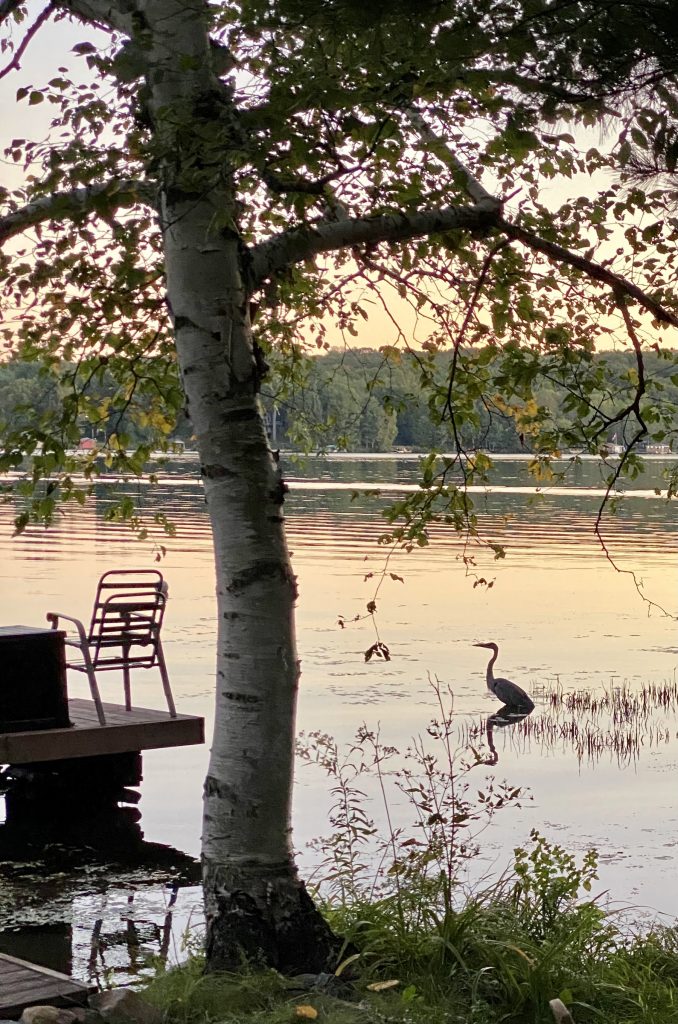
Placing or allowing woody debris to accumulate along the shoreline
Unless a fallen tree is a hazard to boats or swimmers, consider leaving it be! Not a lot of shoreline trees fall around the lake during a year… and clearing a bunch of them away at once can have disastrous consequences to the habitat they were supporting. By the way, submerged wood not only creates hiding and spawning spots for fish, it’s also a major food source for crayfish, aquatic insects, and small fish.
Active planting of native species
So, you’ve already begun to leave the strip of land nearest to your shoreline alone to re-naturalize… but why not help it along even more by planting some native grasses, plants, shrubs, and/or trees? This is also beneficial in terms of appearance – Muskoka has so many beautiful native plant species, so there’s no need to sacrifice the aesthetics of your cottage. People are often surprised how much they love the look of a naturalized shoreline garden.

For more information on plants native to Muskoka, visit Muskoka Watershed Council’s Recreating a Healthy Waterfront.
Removal or “softening” of existing hard structures like retaining walls
While these hard structures may provide a temporary solution to erosion, they can cause damage to neighbouring properties. They can also eventually fail and damage the shoreline they were originally placed to protect.
Instead of removing these structures entirely, there is also the option of protecting the wall (and your shoreline) with softer measures such as planting buffer vegetation. In the case of rip rap, planting can be done between the rocks – the roots of the plants will help with structural integrity, and the foliage of the plants will help to protect against erosion from waves.
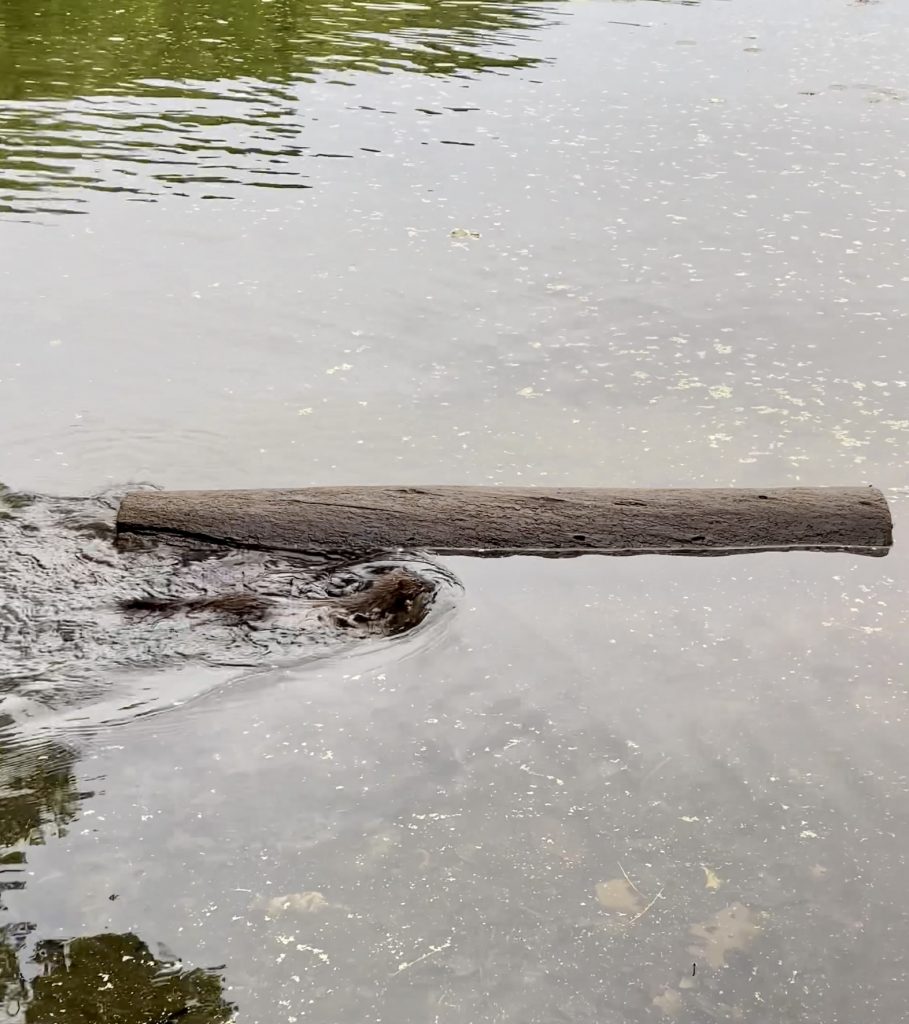
Resources:
For help with naturalizing your shoreline, check out Watershed Canada’s Natural Edge Program, offered by Muskoka Watershed Council.
For native plant selection, visit The Natural Edge’s Plant Database, Muskoka Conservancy’s Native Plant Program, or Muskoka Water Web’s page on Gardening & Landscaping.
For more information about blue-green algae in Muskoka, have a look at Muskoka Watershed Council’s Technical Bulletin on Algae in Muskoka, or learn about their Algae Monitoring Program.
